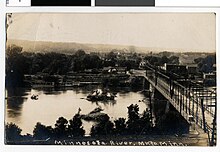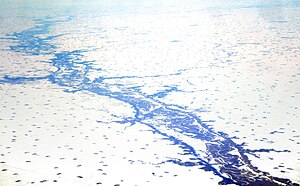Minnesota River
| Minnesota River | |
|---|---|
Big Stone County, MN | |
| • elevation | 964 ft (294 m) |
| Mouth | Mississippi River |
• location | Mendota in Dakota County, Minnesota |
• coordinates | 44°09′51″N 94°02′13″W / 44.16417°N 94.03694°W |
• elevation | 690 ft (210 m) |
| Length | 370 mi (600 km) |
| Basin size | 17,000 sq mi (44,000 km2) |
| Discharge | |
| • location | Fort Snelling State Park |
| • average | 8,356 cu ft (236.6 m3) per sec.[1] |
The Minnesota River (Dakota: Mnísota Wakpá) is a tributary of the Mississippi River, approximately 332 miles (534 km) long, in the U.S. state of Minnesota. It drains a watershed of 14,751 square miles (38,200 km2) in Minnesota and about 2,000 sq mi (5,200 km2) in South Dakota and Iowa.
It rises in southwestern Minnesota, in

The valley that the Minnesota River flows in is up to five miles (8 km) wide and 250 feet (80 m) deep.[6] It was carved into the landscape by the massive glacial River Warren between 11,700 and 9,400 years ago at the end of the last ice age in North America. Pierre-Charles Le Sueur was the first European known to have traveled along the river.[citation needed] The Minnesota Territory, and later the state, were named for the river.
Commercial significance
The river valley is notable as the origin and center of the

Tributaries

| Order of entry | River | Location of confluence |
|---|---|---|
| 11 | Blue Earth River | West side of Mankato |
| 6 | Chippewa River | Montevideo |
| 9 | Cottonwood River | Southeast of New Ulm |
| 13 | Credit River | Scott County, just southeast of Minneapolis–Saint Paul |
| 5 | Lac qui Parle River | Lac qui Parle State Park, 10 mi (15 km) northwest of Montevideo |
| 10 | Little Cottonwood River | Cambria Township , 7 mi (11 km) southeast of New Ulm
|
| 1 | Little Minnesota River | Big Stone Lake in Browns Valley |
| 4 | Pomme de Terre River | Marsh Lake in southwestern Swift County, 4 mi (6 km) southwest of Appleton |
| 8 | Redwood River | Near Redwood Falls |
| 12 | Rush River | 2.9 mi north of Le Sueur |
| 2 | Whetstone River | Ortonville, near the South Dakota state line |
| 3 | Yellow Bank River | Agassiz Township, 3 mi (5 km) southeast of Odessa
|
| 7 | Yellow Medicine River | Sioux Agency Township
|
Cities and towns

See also
Notes and references
- ^ "Minnesota River". USGS. Archived from the original on September 22, 2021. Retrieved June 21, 2021.
- ^ "Mnisota Makoce: A Dakota Place". Bdote Memory Map. Archived from the original on September 21, 2017. Retrieved September 21, 2017.
- ^ "What the Chickadee Knows allows readers another way to read and see and hear landscapes and lives and waters and skies around the confluence of the Minisota and Michizibi Rivers." in Sixteen Poetry Recommendations for National Native American Heritage Month Archived November 2, 2022, at the Wayback Machine, orionmagazine.org, November 10, 2021. Retrieved November 2, 2022
- ^ ""Minnesota State"". Minnesota Historical Society. Archived from the original on March 31, 2015. Retrieved March 21, 2010.
- ISBN 978-0-87351-518-4.
- ^ Sansome, Minnesota Underfoot, pp. 118-19.
- ^ "Peas, corn and beyond: Minnesota's Green Giant company was a canned food pioneer". MinnPost. August 1, 2013. Archived from the original on October 7, 2015. Retrieved October 6, 2015.
- ISBN 978-1-60354-022-3.
- ^ "The Cosgrove Years". Mayohouse.org. Archived from the original on March 24, 2007. Retrieved December 12, 2007.
Sources
- Sansome, Constance Jefferson (1983). Minnesota Underfoot: A Field Guide to the State's Outstanding Geologic Features. Stillwater, MN: Voyageur Press. ISBN 0-89658-036-9.
- Waters, Thomas F. (1977). The Streams and Rivers of Minnesota. Minneapolis: University of Minnesota Press. ISBN 0-8166-0960-8.
- Place Names: the Minnesota River
External links
- Drainage Area of the Minnesota River
- History of the Minnesota River Valley
- Minnesota River at Mankato - pictures and more information
- Minnesota River Basin Data Center - center at Minnesota State University, Mankato
 Texts on Wikisource:
Texts on Wikisource:
- "Minnesota River". Collier's New Encyclopedia. 1921.
- "Minnesota, a river which crosses the state of Minnesota". The New Student's Reference Work. 1914.
- "New International Encyclopedia. 1905.
- "The American Cyclopædia. 1879.
